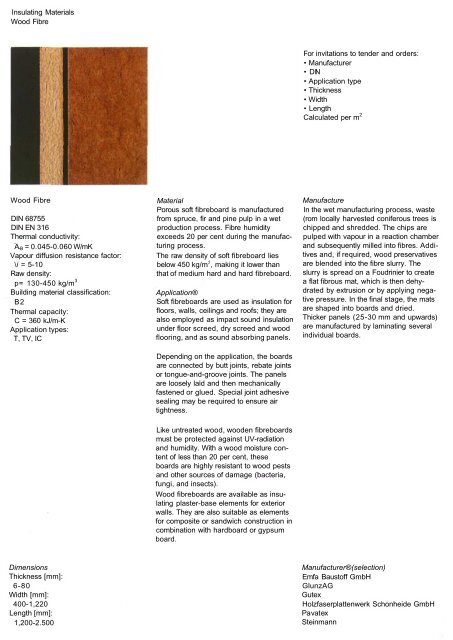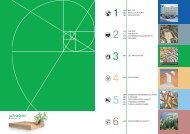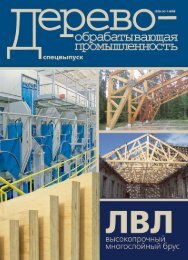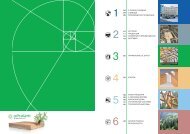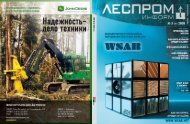Timber Construction
Timber Construction
Timber Construction
Create successful ePaper yourself
Turn your PDF publications into a flip-book with our unique Google optimized e-Paper software.
Insulating Materials<br />
Wood Fibre<br />
Wood Fibre<br />
DIN 68755<br />
DIN EN 316<br />
Thermal conductivity:<br />
A.B = 0.045-0.060 W/mK<br />
Vapour diffusion resistance factor:<br />
\i = 5-10<br />
Raw density:<br />
p= 130-450 kg/m 3<br />
Building material classification:<br />
B2<br />
Thermal capacity:<br />
C = 360 kJ/m-K<br />
Application types:<br />
T, TV, IC<br />
Dimensions<br />
Thickness [mm]:<br />
6-80<br />
Width [mm]:<br />
400-1,220<br />
Length [mm]:<br />
1,200-2.500<br />
Material<br />
Porous soft fibreboard is manufactured<br />
from spruce, fir and pine pulp in a wet<br />
production process. Fibre humidity<br />
exceeds 20 per cent during the manufacturing<br />
process.<br />
The raw density of soft fibreboard lies<br />
below 450 kg/m ;i , making it lower than<br />
that of medium hard and hard fibreboard.<br />
Application®<br />
Soft fibreboards are used as insulation for<br />
floors, walls, ceilings and roofs; they are<br />
also employed as impact sound insulation<br />
under floor screed, dry screed and wood<br />
flooring, and as sound absorbing panels.<br />
Depending on the application, the boards<br />
are connected by butt joints, rebate joints<br />
or tongue-and-groove joints. The panels<br />
are loosely laid and then mechanically<br />
fastened or glued. Special joint adhesive<br />
sealing may be required to ensure air<br />
tightness.<br />
Like untreated wood, wooden fibreboards<br />
must be protected against UV-radiation<br />
and humidity. With a wood moisture content<br />
of less than 20 per cent, these<br />
boards are highly resistant to wood pests<br />
and other sources of damage (bacteria,<br />
fungi, and insects).<br />
Wood fibreboards are available as insulating<br />
plaster-base elements for exterior<br />
walls. They are also suitable as elements<br />
for composite or sandwich construction in<br />
combination with hardboard or gypsum<br />
board.<br />
For invitations to tender and orders:<br />
• Manufacturer<br />
•DIN<br />
• Application type<br />
• Thickness<br />
• Width<br />
• Length<br />
Calculated per m 2<br />
Manufacture<br />
In the wet manufacturing process, waste<br />
(rom locally harvested coniferous trees is<br />
chipped and shredded. The chips are<br />
pulped with vapour in a reaction chamber<br />
and subsequently milled into fibres. Additives<br />
and, if required, wood preservatives<br />
are blended into the fibre slurry. The<br />
slurry is spread on a Foudrinier to create<br />
a flat fibrous mat, which is then dehydrated<br />
by extrusion or by applying negative<br />
pressure. In the final stage, the mats<br />
are shaped into boards and dried.<br />
Thicker panels (25-30 mm and upwards)<br />
are manufactured by laminating several<br />
individual boards.<br />
Manufacturer® (selection)<br />
Emfa Baustoff GmbH<br />
GlunzAG<br />
Gutex<br />
Holzfaserplattenwerk Schonheide GmbH<br />
Pa vat ex<br />
Steinmann<br />
Bituminated Fibreboard [Asphalt-<br />
Treated Board; US]<br />
[DIN 68752<br />
lermal conductivity:<br />
^ = 0.056-0.060 W/mK<br />
'apour diffusion resistance factor:<br />
= 5-10<br />
Raw density:<br />
p = 200-350 kg/m 3<br />
Building material classification:<br />
B2<br />
Fhermal capacity:<br />
C - 630 kJ/m ; 'K<br />
\pplication types:<br />
T,TV<br />
"isions<br />
nickness [mm]:<br />
16-25<br />
Wdth [mm]:<br />
[400-1,220<br />
Length [mm]:<br />
[2,440,2,500<br />
Material<br />
Bituminated fibreboards are porous wood<br />
fibreboards, manufactured with a bitumen<br />
additive.<br />
A distinction is made between bituminated<br />
(ibreboards<br />
• with 10-15 per cent bitumen additive<br />
(moisture-proof) and a water absorption<br />
rate of less than 25 per cent (BPH)<br />
• with more than 15 per cent bitumen<br />
additive (increased moisture resistance)<br />
and an average water absorption of less<br />
than 20 per cent (BPH2).<br />
Application®<br />
The primary areas of application ar& exterior<br />
walls, roof extensions and subfloors.<br />
Bitumen-impregnated wood fibreboards<br />
can be used under roof covering as<br />
water- and airtight layers. The bitumen<br />
content renders them resistant to moisture,<br />
rot, fungi and insects.<br />
Insulating Materials<br />
Bituminated Fibreboard<br />
For invitations to tender and orders:<br />
• Manufacturer<br />
•DIN<br />
• Application type<br />
• Thickness<br />
• Width<br />
• Length<br />
Calculated per m /<br />
Manufacture<br />
Bituminated wood fibreboards are manufactured<br />
in the same manner as porous<br />
wood fibreboards; the only difference<br />
being that a bitumen emulsion is added<br />
to the fibre slurry.<br />
Manufacturer® (selection)<br />
Emfa Baustoff GmbH<br />
Gutex<br />
Isofloc Warmedammtechnik GmbH<br />
Pavatex


